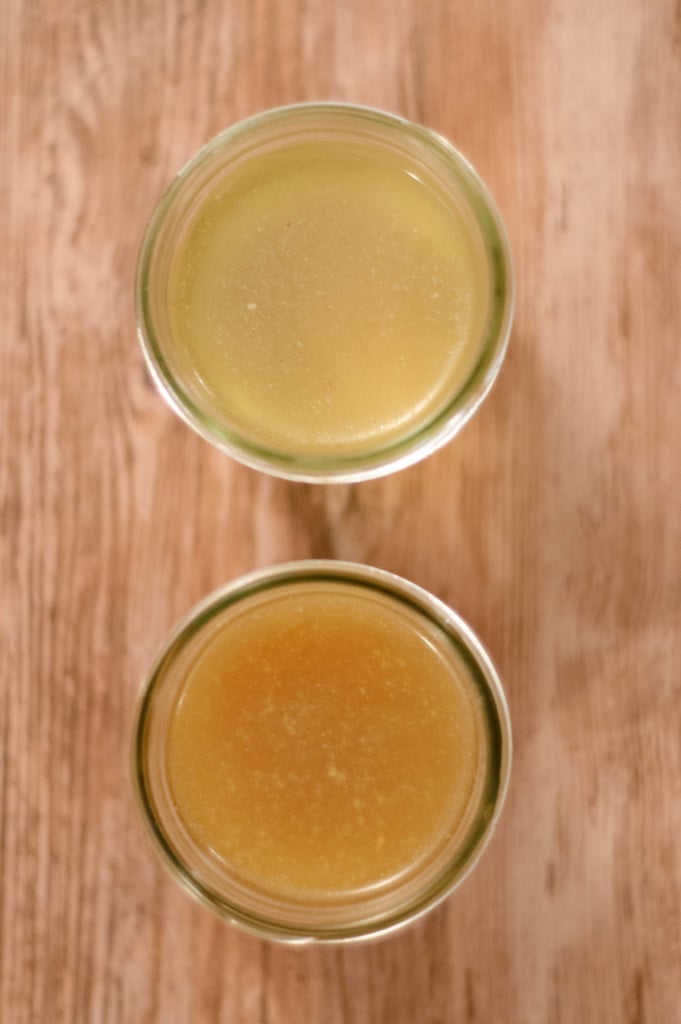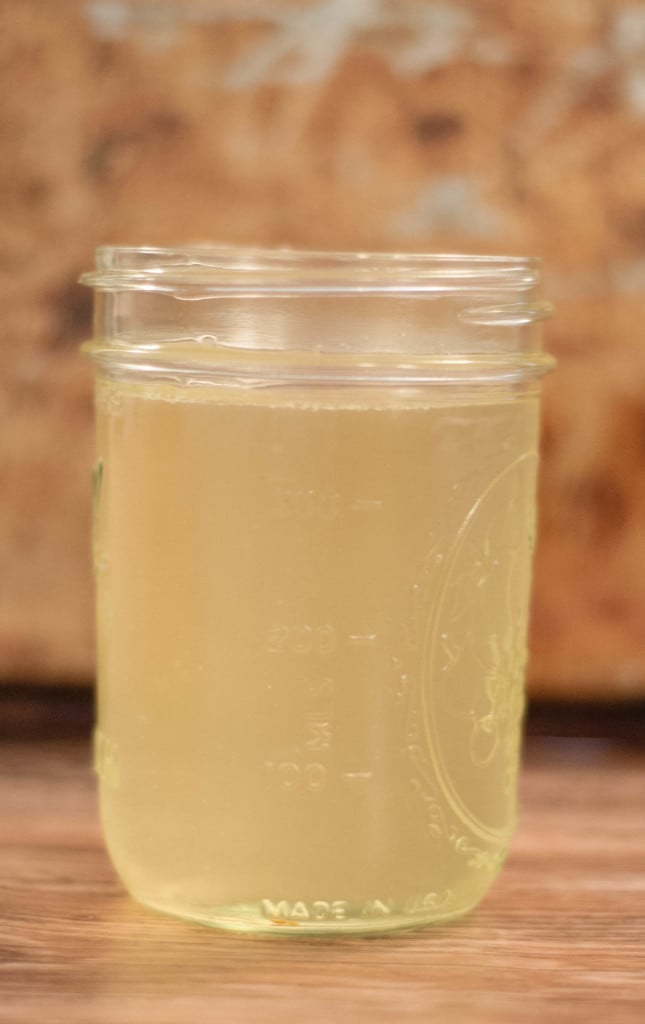Making a perfect white stock is easy with these 8 little-known tips. Get a crystal clear broth that will sparkle in soups or shine in sauces.
This post was originally published on March 9, 2016. It has been updated for clarity.

Unless you have dabbled in French mother sauces before, chances are pretty slim that you’ve made a white stock. This beautiful liquid is light in color and almost see-through. It is perfect for making consommé, serving with fish, or in sauces like velouté.
What Is A White Stock?
White stock is a flavorful liquid made by simmering bones, vegetables, and aromatics. It is almost perfectly clear and light in flavor, which makes it ideal for very light dishes.
Unlike brown stock, this one uses the process of blanching bones to remove impurities instead of roasting them. This prevents the bones from caramelizing, which gives the darker color of a brown stock.
What Is The Difference Between Stock and Broth?
The main difference between stock and broth is that stock simmers bones, while broth simmers meat, like from a roasted chicken. The bones give a stronger flavor and thicker consistency to stock, while broth stays thin and light.
For most home cooks, broth and stock are interchangeable. However, the process of making homemade stock is more involved, requiring extra steps like skimming the scum away, or roasting bones.

Why Should I Blanch the Bones?
Learning how to blanch bones and how to make white stock go hand-in-hand. The method is the same as blanching vegetables, but the process has a few important nuances that ensure the stock is clear, flavorful, and free of imperfections.
Whenever you get bones from the butcher, or remove them from the meat yourself, it is extremely hard to remove all of the blood and other nasty bits that hide in the different nooks and crannies of the bones. These impurities can cause cloudiness when making stock.
Did You Know? Young animals, like veal or chicken, have the highest amount of blood and impurities in their bones.
For some, blanching the bones causes an unnecessary loss of flavor that could contribute to the stock. So that leaves you with two potential options: blanch the bones before making the stock, or skim the impurities while it simmers.
I personally prefer to blanch and drain my bones because once I’ve started my stock it can be difficult to get around the vegetables and sachet when skimming. (Although there are hacks to make skimming stock easier.) Plus, keeping up with skimming can get exhausting!
Whichever way you choose for making your white stock is completely up to you. Both are great options!

Things To Do Before Cooking
White stocks are significantly less common than brown and mostly used for very specific recipes, not day-to-day use. Use some of these chef tested tips to get the most out of your stock.
- Instead of the basic carrot, celery, and onion mixture, white stock uses a “white mirepoix”, or, a mirepoix without carrots. You can also add mushroom trimmings or leeks to boost flavor.
- To help remove impurities, cut the bones into pieces that are 2-4 inches in size. If you don’t have the equipment available to do this, your butcher should. They are usually happy to help if you ask.
- Since you are not roasting the impurities off of the bones, you have to clean them another way: blanching. To make it even easier on yourself, rinse the bones in cold water first to remove anything from the surface before blanching.
Tips For Cooking The White Stock
- Always start with cold water when making stock. This helps the proteins and fat rise to the top in large pieces that are easy to skim as the temperature of the water rises.
- Simmer the stock, but don’t bring it to a boil. The rapid speed of boiling is likely to make the ingredients break apart and release small particles. Since a white stock focuses on clarity, keeping the stock at a simmer helps avoid clouding the stock.
- During the process of stock-making, fat and coagulated proteins rise to the surface as a type of dingy foam. If you’re not careful, you can push these back down into the liquid, which redistributes them and causes cloudiness. Carefully skim the scum as it rises to prevent redistribution.
- To prevent any caramelization, keep the bones constantly submerged. Once they touch air they are likely to darken, which discolors your stock and stops the flavor from releasing into the water. If needed, skim your water first, then carefully add in more to keep the bones immersed.
- White stocks need a little extra attention during straining. In order to keep every unnecessary chunk or particle out of it, strain your stock through a fine mesh sieve that is lined with many layers of cheesecloth. Still not sure you got it all? Re-line the sive with fresh cheesecloth and strain it a second time.
Tip: When you are ready to strain the stock, turn off the heat and gently add some cold water to the stock pot and let it stand for 10 minutes or so. This helps cool the stock, stop the cooking, and encourage any remaining fat or impurities to come to the surface for a final skimming.

How To Make White Stock
You can cook white stock using almost any type of bones. Chicken bones are the most common, but fish or veal bones follow after. Whichever flavor profile you choose, the process remains the same.
Make grocery shopping easier with this printable grocery list for this white stock recipe.
Use this grocery list to help simplify shopping. All ingredients are listed in standard grocery store amounts. If no size is specified, even the smallest package will provide more than enough.
Happy Cooking! 🙂

How To Make A White Stock
Ingredients
Stock
- 3 lbs bones
- 3 quarts cold water, plus more for blanching
- 4 oz onion, (roughly one cup), chopped
- 2 oz celery, (roughly ¼ cup), chopped
Sachet
- ½ bay leaf
- ½ teaspoon fresh thyme
- ½ teaspoon whole black peppercorns
- 2-3 parsley stems
- ½ whole clove
Instructions
Blanch The Bones
- Rinse the bones and place them in a large stock pot. Add cold water to the pot and bring it to a boil; roughly 30 minutes. Carefully drain the bones and rinse them under running water. If you're reusing the same stock pot, quickly wash it out to remove any scum.
Stock
- Place the bones back in the stock pot and cover them with three quarts of cold water. Heat the stock over medium heat avoiding letting the stock boil. Reduce the heat as needed to keep it at a simmer. Gently skim the scum off the top as needed.
- Trying not to aggravate the stock, slowly add in the onions, celery, and sachet. Add water as needed to keep the bones submerged.
- Cooking times vary depending on the type of bones you add. See below for my recommendations.*
Strain
- Remove the stock from the heat, skim away any scum, and gently add up to 2 cups of cold water. Let sit for 10 Minutes. Skim away any additional scum that rises to the top.
- Carefully strain the stock through a fine-mesh sieve lined with several layers of cheesecloth and cool the stock in a food-safe way, like in a cold-water bath. This recipe should yield about 2 quarts of white stock.
Notes
- The sachet is more or less the same as a bouquet garni. The difference is it helps contain any pieces that dissolve or break apart during cooking. This ultimately keeps down the amount of skimming you need to do.
- *Recommended Cooking Times:
- Turkey, ham, and chicken stock should simmer in the water for about 2-3 Hours.
- Lamb, veal, and beef stock for 3-4 hours.
- Fish only needs around one hour



What are your thoughts?